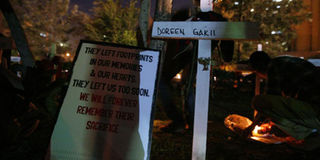Garissa attack: 147 wasn’t just a number, they were beloved

A man lights a candle next to a cross with the name of one of the Garissa University College students during an April 14 concert at Uhuru Park’s Freedom Corner in memory of those who lost their lives. PHOTO | EVANS HABIL | NATION MEDIA GROUP
What you need to know:
- Garissa University was the crucible of their hopes and dreams; their only ticket to escape poverty.
- Many were misled by the terrorists’ false promise that if they came out of their hiding, their lives would be spared.
- Most of them were second and first year students pursuing education and business management courses.
147 was not just a number. They were not just 147 disfigured bodies; they were 147 lives lost, 147 dreams snuffed out, 147 families robbed off their hopes.
For most of the families whose children were killed in the Garissa University College attack, the students were their only source of hope for a better future. Many of the young students were the only ones in their families who had made it so far. Their parents had sold property and livestock to keep them in college.
Still, some of those who lost their lives were orphans with younger siblings looking up to them for guidance and financial support while others were looking after their elderly grandparents.
Garissa University was the crucible of their hopes and dreams; their only ticket to escape poverty.
The young men and women who died were not only pillars of their families but of their communities, too.
Some were killed in their beds as they slept, others as they tried to scale over the fence as they fled for their lives in the dark. Many were shot in the back as they tried to take cover in the school field.
FALSE PROMISE
Many were misled by the terrorists’ false promise that if they came out of their hiding, their lives would be spared. The braver ones dared to fight back but lost the battle. Some had already left their hostels and scampered into safety when they remembered that they had left their friends in danger and went back to save them, only to lose their lives in the process.
As they sent text messages and called their parents in the face of danger, most of them knew that would be the last time they were talking to their loved ones, saying their final goodbyes on phone.
Although their lives were cut short before they could reach their prime, they have left behind parents who heard their children being shot repeatedly over the phone and who will never get over that pain.
They left behind relatives who had to identify them not by face, but by inspecting their dental structures and birthmarks because their faces were disfigured by their killers’ bullets. They died young.
Most of them were second and first year students pursuing education and business management courses.
They were aged between 18 and 23, with dreams of finishing college and becoming teachers, shaping the minds of future generations, starting their own businesses or making their contribution in big organisations. Dreams that were never to be.
Although most of them were jittery about schooling in Garissa at first, they soon familiarised themselves with the sweltering heat and Garissa University College became their home and the community became their community. Little did they know that they would meet their worst fate in the very place where their dreams beckoned.





